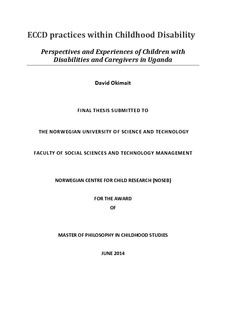| dc.description.abstract | CWDs are regarded as one of the most vulnerable groups of children who are marginalised by virtue of their disability status. The different ways in which childhood disability is constructed within Ugandan societies continues to reflect on CWDs as passive beings. This study was informed mainly by the Sociology of Childhood whose first stance is to regard children as active beings in their own right. The study was further informed by the rights based approach facilitated by the CRC, ACRWC and CRPWD. The argument reflected in this study from a rights based perspective is participation rights of CWDs. The study appreciated the fact that, CWDs have different capabilities and therefore, developed multiple and participatory methods for their benefit. Some of them included; drawing, recall, observation, and visual-listening. Because the study was inclusive of adult caregivers, interviews also informed part of this study. The study which combined the aspect of disability and ECCD, sought to answer the research questions of; how CWDs within community and institutionalised centres experience ECCD in regard to learning and healthcare. Furthermore, it asked the question of how children’s rights to care, learning and participation are practiced within the ECCD programmes in Uganda. The findings of this study are structured into two themes of learning and healthcare which form part of the ECCD practice.
In the learning theme, it revealed that interaction facilitated children’s learning processes. The social environment within the institution and home were both seen as facilitating children’s learning process. It also presented the element of time as a very important factor in the learning process. It also revealed that it was critical for the home caregivers to also learn techniques and skills for caring for CWDs. It revealed that communication was a critical issue within CWDs spaces. It particularly facilitated children’s agency. In regard to healthcare, the study revealed that therapy and rehabilitation processes went beyond the restoration or achievement of ‘normality’ of disability, as suggested by the medical model of disability. It also revealed the CBR approach as being critical to the realisation of ECCD. In the wrap up of the study, it discusses the complexities to CWDs’ learning such as absence of the male home caregivers in the child’s lives and then further looks at the aspects that exclude CWDs in society. It also wraps up the healthcare discussion by discussing poverty which was revealed to be a major obstacle to child disability management in the home and as such, directly reflected on the lives of the CWDs and their caregivers. | nb_NO |
